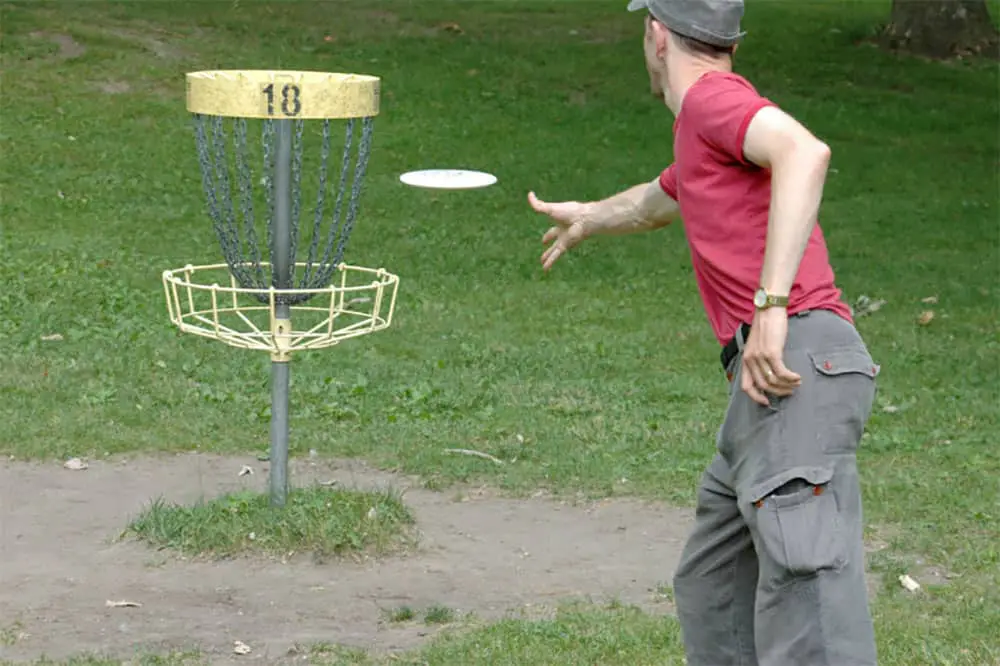Disc golf is a variation of “regular” golf played with many of the same rules, but with a frisbee-type disc instead.
The flying disc sport is becoming increasingly more popular around the world as players attempt to get the disc into a specially designed target (basket) in the lowest number of throws possible.

Just like using different clubs in traditional golf, different types of disc are used for different throws, designed to go either short or long distances, curve left or right, or even travel across the ground.
What’s A Jump Putt?
For those of you unfamiliar with a “jump putt”, it’s essentially the practice of a disc golfer jumping as they release the putter.
The principal aim of a jump putt is to generate additional power and gain extra distance while still maintaining good control of the shot with a putt instead of a full throw.
Most putting forms in disc golf generate some power from the legs and the rest from the shoulder, elbow and wrist. However, for some of the longer putts, this doesn’t provide enough power to reach the basket, so squatting down and jumping is required to make up the distance.
Understandably, jump putts can often sacrifice some control for the extra distance. Nevertheless, they’re still more accurate and controllable than approach shots which explains why they’re so frequently used.
This guide will take a detailed look at some of the different styles of jump putts in disc golf, as well as the main rules to keep in mind.
The Rules
Before we take a closer look at the various jump putts disc golfers use to reach the basket, it’s important to understand some of the key rules. Listed below is a brief outline of jump putting rules.
- The putt must be completed with at least foot inside your lie
- Neither foot is allowed to touch the ground in front of your lie
- You must release the putter before your feet leave the ground
- You’re then allowed to jump over your lie if you’re outside Circle 1
- You’re unable to jump over your lie if you’re inside Circle 1
What’s A Jump Putt Lie?
Understanding your lie is one of the most essential rules for jump putting. As stated by the Professional Disc Golf Association (PDFA), the lie is a rectangle 20 cm wide and 30 cm deep that’s centered on the line of play behind the rear edge of the marker disc.
As briefly touched upon in the rules above, you must jump putt with one foot in your lie and you shouldn’t have the other foot on the ground any closer to the basket than the front of your lie.
Release
When releasing your putter in a jump putt, it’s imperative that you have one balancing body part inside the lie. This means that while in the process of jump putting, you must release the disc before the foot that is touching your lie leaves the ground.

To put it simply, you can’t jump and then proceed to throw the putter while in mid-air. This is one of the rules that confuses most newcomers to the sport and can be difficult to accomplish.
If you fail to release the putter before your foot has left your lie, this is a stance violation and will result in a penalty throw in favor of the opposition.
Jumping
So long as you have one foot inside your lie at the moment you release your putter, you’re then permitted to jump over your lie if you’re outside of Circle 1. As defined by the PDGA, this circle is any area “within 10 meters of the target, as measured from the rear of the marker disc to the base of the target”.
Also, keep in mind that while you’re unable to have a foot on the ground in front of your lie when you let go of the putter, you can have one foot positioned to the side as long as it’s in bounds.
If, however, you’re within Circle 1, a standard jump putt is illegal. This is because inside Circle 1, you’re expected to demonstrate full control of balance before advancing towards the target. A jumping motion associated with a jump putt isn’t interpreted as control of balance.
Jumping or stepping over your lie before demonstrating full balance results in a stance violation and therefore, a penalty throw.
How To Jump Putt
There are several types of jump putts and even more form variations within each style. We’ll now take a look at a couple of the most popular.
Spin Jump Putt
This is the most common type of disc golf jump putt that you’ll come across. To start the movement, get into a normal spin putting position with your feet shoulder width apart, your front foot pointed towards the basket, your back foot staggered behind, and your chest directly facing the basket.
After identifying the perfect spot to aim, pull the putter into your body and squat down – remembering to keep both your head and chest up. Then, explode upward so you can fling the disc the required distance. Finally, make sure you snap your wrist outward to throw your putter just as your body fully extends.
Straddle Jump Putt
This technique is a little less natural for the vast majority of disc golfers, but still offers a few advantages. Start in a straddle putt stance, dropping your putter down lower than with a spin putt jump.
As you start to extend, keep your weight on your heels before squeezing your hamstrings and driving your hips forward to transfer this weight forward onto the balls of your feet instead. Give a forceful push with your shoulder and flick your fingers outward so they propel the putter just at the point your body reaches full extension.
Recommended Discs
Generally, the best jump putting putters are high glide, fast and stable. The high glide and speed qualities help you to reach the basket on longer putts, while a stable putter is significantly more versatile than an understandable or overstable putter.
Listed below are four of the most popular and best-performing discs for jump putting.
- Latitude 64 Pure
- Dynamic Discs Judge
- Discraft Roach
- Dynamic Discs Warden
Final Thoughts
Now that we’ve explained how to jump putt legally and effectively, use the skill wisely. It’s definitely a good idea to do plenty of jump putting practice before trying it in a tournament because it’s not a natural movement for most people.
Furthermore, you’ll want to get familiar with releasing the disc at higher and lower angles, and become efficient at estimating the proper amount of power.
